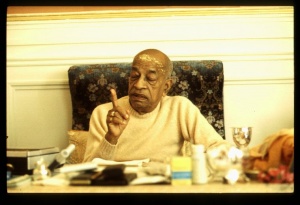SB 11.5.27

A.C. Bhaktivedanta Swami Prabhupada
Please note: The synonyms, translation and purport of this verse were composed by disciples of Śrīla Prabhupāda
TEXT 27
- dvāpare bhagavāñ śyāmaḥ
- pīta-vāsā nijāyudhaḥ
- śrīvatsādibhir aṅkaiś ca
- lakṣaṇair upalakṣitaḥ
SYNONYMS
dvāpare — in Dvāpara-yuga; bhagavān — the Supreme Lord; śyāmaḥ — dark blue; pīta-vāsāḥ — wearing a yellow garment; nija-āyudhaḥ — having His own particular weapons (the disc, club, conchshell and lotus flower); śrīvatsa-ādibhiḥ — by Śrīvatsa and others; aṅkaiḥ — bodily marks; ca — and; lakṣaṇaiḥ — by ornaments; upalakṣitaḥ — characterized.
Translation and purport composed by disciples of Śrīla Prabhupāda
TRANSLATION
In Dvāpara-yuga the Supreme Personality of Godhead appears with a dark blue complexion, wearing yellow garments. The Lord's transcendental body is marked in this incarnation with Śrīvatsa and other distinctive ornaments, and He manifests His personal weapons.
PURPORT
The Lord's transcendental body in Dvāpara-yuga can be compared to the color of a dark blue flower. The Lord exhibits His personal transcendental weapons such as Sudarśana cakra, and all of the limbs of His body, especially His hands and feet, are decorated with auspicious symbols such as a lotus flower and a flag. And on His chest, the Lord manifests the Kaustubha jewel as well as the auspicious Śrīvatsa, a whorl of hair curling from left to right on the right side of the Lord's chest. Actually, such auspicious marks as Kaustubha and Śrīvatsa, as well as the weapons of the Lord, are present in all of the viṣṇu-tattva incarnations. Śrīla Jīva Gosvāmī explains that these universal characteristics of the Lord mentioned by the sage Karabhājana are indications of the Kṛṣṇa avatāra. Because Kṛṣṇa is the source of all incarnations, all of the symptoms of all other incarnations are to be found in His transcendental body.